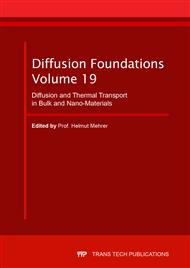[1]
Á. W. Imre, Measures of the Performance and Scalability,, in ELECTRIC VEHICLES LAND, SEA, AIR,, Santa Clara, (2012).
Google Scholar
[2]
H. Gerischer, F. Decker and B. Scrosati, The Electronic and the Ionic Contribution to the Free Energy of Alkali Metals in Intercalation Compounds,, J. Electrochem. Soc., vol. 141, 2297-2300, (1994).
DOI: 10.1149/1.2055115
Google Scholar
[3]
G. Amatucci, J. Tarascon and L. Klein, CoO2, The End Member of the LixCoO2 Solid Solution,, J. of The Electrochem. Society, vol. 143, no. 3, 1114-1123, (1996).
DOI: 10.1149/1.1836594
Google Scholar
[4]
J. Molenda and A. Stoklosa, Modification in the electronic structure of cobalt bronze LixCoO2 and the resulting electrochemical properties,, Soilid State Ionics, vol. 36, no. 1-2, 53-58, (1989).
DOI: 10.1016/0167-2738(89)90058-1
Google Scholar
[5]
F. Jiang and P. Peng, Elucidating the Performance Limitations of Lithium-ion Batteries due to Species and Charge Transport through Five Characteristic Parameters,, Scientific Reports, vol. 6, (2016).
DOI: 10.1038/srep32639
Google Scholar
[6]
C. Kupper and W. G. Bessler, Multi-Scale Thermo-Electrical Modeling of Performance and Aging of a LiFePO4/Graphite Lithium-Ion Cell,, J. of The Electrochem. Society, vol. 164, A304-A320, (2017).
DOI: 10.1149/2.0761702jes
Google Scholar
[7]
K. Ozawa, (Eds.) Lithium Ion Rechargeable Batteries, Wiley-VCH, (2009).
Google Scholar
[8]
S. Yamakawa, H. Yamasaki, T. Toshiyuki and R. Asahi, Numerical study of Li diffusion in polycrystalline LiCoO2,, J. of Power Sources, vol. 223, 199-205, (2013).
DOI: 10.1016/j.jpowsour.2012.09.055
Google Scholar
[9]
M. Bernardi and J.-Y. Go, Analysis of pulse and relaxation behavior in lithium-ion batteries,, J. of Power Sources, vol. 196, 412-427, (2011).
DOI: 10.1016/j.jpowsour.2010.06.107
Google Scholar
[10]
B. Delattre, R. Amin, J. Sander, J. De Coninck, A. Tomsia and Y.-M. Chiang, Impact of Pore Tortuosity on Electrode Kinetics in Lithium Battery Electrodes: Study in Directionally Freeze-Cast LiNi0.8Co0.15Al0.05O2 (NCA),, J. of The Electrochem. Society, vol. 165, no. 2, A388-A395, (2018).
DOI: 10.1149/2.1321802jes
Google Scholar
[11]
T. Danner, M. Singh, S. Hein, J. Kaiser, H. Hahn and A. Latz, Thick electrodes for Li-ion batteries: A model based analysis,,, J. of Power Sources, vol. 334, 191-201, (2016).
DOI: 10.1016/j.jpowsour.2016.09.143
Google Scholar
[12]
D.-W. Chung, P. R. Shearing, N. P. Brandon, S. J. Harris and R. E. Garcia, Particle Size Polydispersity in Li-Ion Batteries,, J. of The Electrochemical Society, vol. 161, no. 3, A422-A430, (2014).
DOI: 10.1149/2.097403jes
Google Scholar
[13]
A. Jossen, J. of Power Sources, vol. 154, no. 2, 530-538, (2006).
Google Scholar
[14]
M. Lewerenz, A. Warnecke and D. U. Sauer, Introduction of capacity difference analysis (CDA) for analyzing lateral lithium-ion flow to determine the state of covering layer evolution,, Journal of Power Sources, vol. 354, 157-166, (2017).
DOI: 10.1016/j.jpowsour.2017.04.043
Google Scholar
[15]
J. Wilhelm, Cycling capacity recovery effect: A coulombic efficiency and postmortem study,, J. of Power Sources, vol. 365, 327-338, (2017).
DOI: 10.1016/j.jpowsour.2017.08.090
Google Scholar
[16]
T. Waldmann, M. Wilka, M. Kasper, M. Fleischhammer and M. Wohlfahrt-Mehrens, Temperature dependent ageing mechanisms in Lithium-ion batteries - A Post-Mortem study,, J. o Power Sources, vol. 262, 129-135, (2014).
DOI: 10.1016/j.jpowsour.2014.03.112
Google Scholar
[17]
Y. Wu, P. Keil, S. Schuster and A. Jossen, Impact of Temperature and Discharge Rate on the Aging of a LiCoO2/LiNi0,8Al0,05O2 Lithium-Ion Pouch Cell,, J. of The Electrochem. Society, vol. 164, no. 7, A1438-A1445, (2017).
DOI: 10.1149/2.0401707jes
Google Scholar
[18]
V. Döge, C. Kurtulus, V. Hennige and R. Wegmann, Scalable energy storage systems for effective electrified mobility concepts,, Transportation Research Procedia, vol. 14, 3621-3630, (2016).
DOI: 10.1016/j.trpro.2016.05.430
Google Scholar
[19]
T. Zimmermann, P. Keil, M. Hofmann, M. F. Horsche and S. Pichlmaier, Review of system topologies for hybrid electrical energy storage,, J. of Energy Storage, vol. 8, 78–90, (2016).
DOI: 10.1016/j.est.2016.09.006
Google Scholar
[20]
R. Wegmann, V. Döge, J. Becker and U. D. Sauer, Optimized operation of hybrid battery systems for electric vehicles using deterministic and stochastic dynamic programming,, J. of Energy Storage, vol. 14, 22-38, (2017).
DOI: 10.1016/j.est.2017.09.008
Google Scholar
[21]
W. Zuo, R. Li, C. Zhou, Y. Li, J. Xia and J. Liu, Battery-Supercapacitor Hybrid Devices: Recent Progress,, Advanced Science News, vol. 4, 1-21, (2017).
DOI: 10.1002/advs.201600539
Google Scholar
[22]
P. Keil, M. Englberger and A. Jossen, Hybrid Energy Storage Systems for Electric Vehicles: An Experimental Analysis of Performance Improvements at Subzero Temperatures,, IEEE Transactions on Vehicular Technology, vol. 65, no. 3, 998-1006, (2016).
DOI: 10.1109/tvt.2015.2486040
Google Scholar
[23]
W. Sarwar, T. Engstrom, M. Marinescu, N. Green and N. Taylor, Experimental analysis of Hybridised Energy Storage Systems for automotive applications,, J. of Power Sources, vol. 324, 388-401, (2016).
DOI: 10.1016/j.jpowsour.2016.05.114
Google Scholar
[24]
A. P. Schmidt, M. Bitzer, Á. W. Imre and L. Guzzella, J. of Power Sources, vol. 195, 7634-7638, (2010).
Google Scholar
[25]
Á. W. Imre, Towards High-Performance Powertrain Solutions,, in Advanced Automotive & Industrial Battery Conference, Mainz, (2018).
Google Scholar


